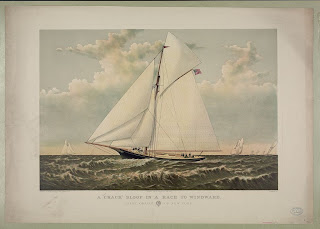Print showing a sloop of the configuration of the USS Rosalie. Source: Library of Congress on-line image library.
The coast of southwest Florida, from the Keys to Tampa Bay, was practically uninhabited through much of the Civil War, almost the very definition of “remote.” Small fishing villages appear to have existed at Ft. Myers and Punta Gorda, along with a few hardy souls living in camps on some of the old Calusa Indian shell middens scattered throughout Pine Island Sound and the Ten Thousand Islands region to the south. The coast was part of the patrol sector of the East Gulf Blockading Squadron. The major water body in this region was the estuarine bay Charlotte Harbor. Two rivers, the Peace and Myakka, drained into this bay from the state’s interior. Just south of the entrance to the bay, the Caloosahatchee River emptied into San Carlos Bay. Because of its remoteness, the region proved irresistible to blockade runners and did see some activity.
On 6 July 1863, Acting Master W. R. Browne from the bark USS Restless took on board two white refugees from the area. They told him that two Confederate blockade runners had attempted a run out that morning. Browne sent out a party of 36 men in the bark’s two cutters, under the command of Acting Ensigns Eason and Russel and Acting Master’s Mate Browne, guided by the two refugees. Their objective was to find the sloop USS Rosalie, with orders for her commander Acting Ensign Charles P. Clark, and then with the Rosalie attempt to locate the runners. The Rosalie was supposed to be stationed in Pine Island Sound. Rosalie in this case was not the larger "sloop-of-war" such as the USS Cumberland; she was a shallow-draft, single-masted sailing ship. She was actually a captured blockade runner and highly useful in the shallow inshore waters of southwest Florida. She was armed with a 12-pdr Dahlgren boat howitzer.
The boats from the Restless did not find the sloop in this location, and so they headed up the Peace River to the small settlement of Punta Gorda. The next morning, they sighted the Rosalie about 5 miles upriver. Upon pulling up to the sloop, they were told by Ensign Clark that he had moved the sloop to the mouth of the river. About 9 AM the morning of the sixth, he saw a sloop and a schooner making a run up the river (probably they had been on their way down when they sighted the Union gunboat and “turned tail”). He set off in pursuit, but it was his misfortune to ground the sloop on a sand bar in the river. The Confederate runners continued upstream, no doubt having a better knowledge of the river channel. By the time the Restless’ boats had reached the Rosalie, Clark had succeeded in freeing her from the bar. The boats and the sloop continued upriver, until shoal water would not allow the sloop to proceed further on the evening of the seventh.
Clark anchored for the night, at this time about 45 miles upriver. The next morning, 8 July, Clark left the sloop in charge of Acting Master's Mate Browne, took command of the two Restless boats, and pushed further upriver to Horse Creek, where they found the two runners unmanned. They were the Bahamian schooner Ann and an un-named sloop, both loaded with cotton. The naval expedition took possession of the two runners and their cargo and made their way back down to the Rosalie, then back out the bay to rejoin the Restless the afternoon of 9 July. For their actions, Adm. Bailey issued a letter of commendation to Acting Master Browne and the crew of the Restless, and promoted Clark from Acting Ensign to Acting Master.
An 1868 Navigation Map of the Charlotte Harbor entrance is at: http://historicalcharts.noaa.gov/tiled/zoomifypreview.html?zoomifyImagePath=CP1121C


No comments:
Post a Comment